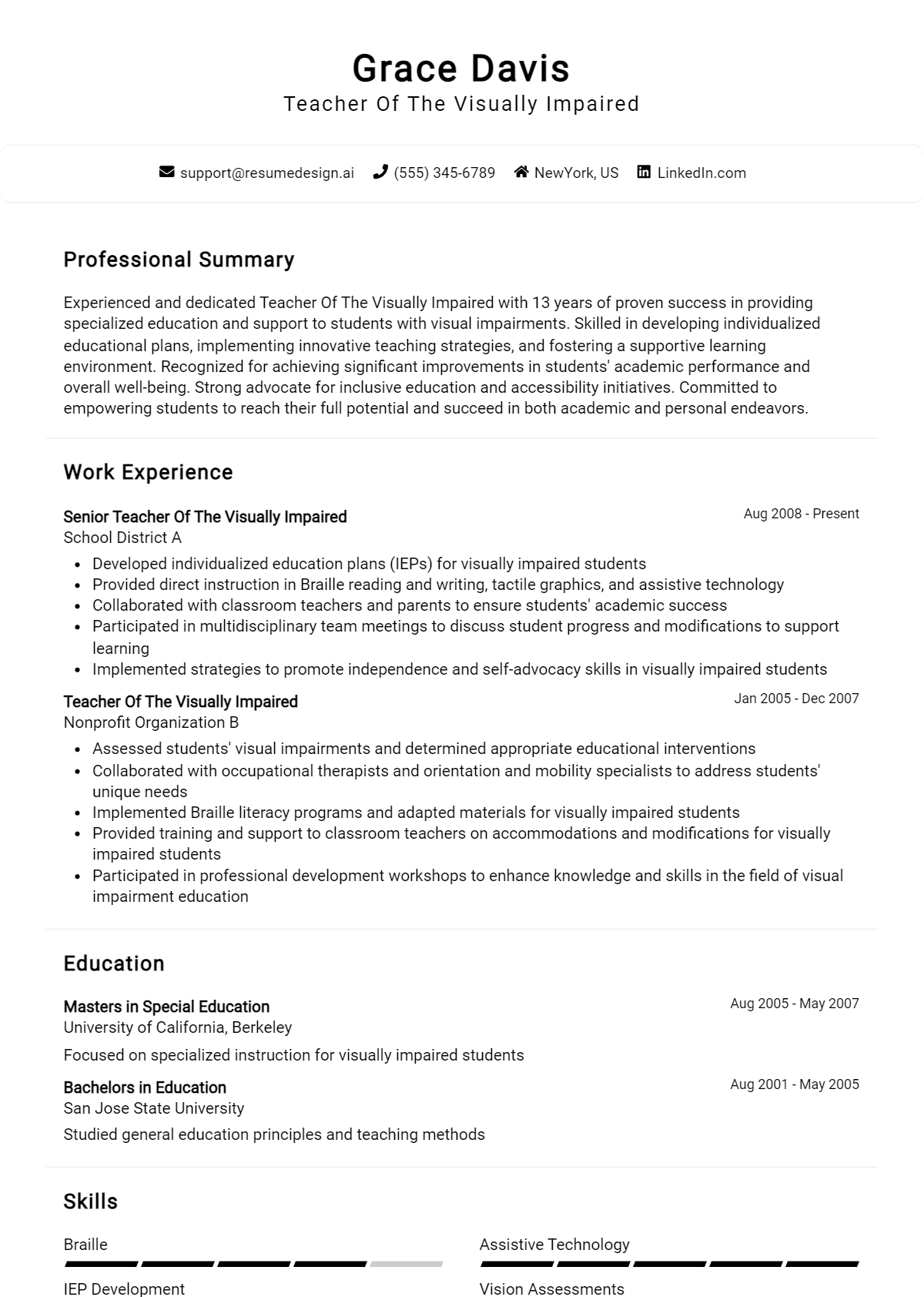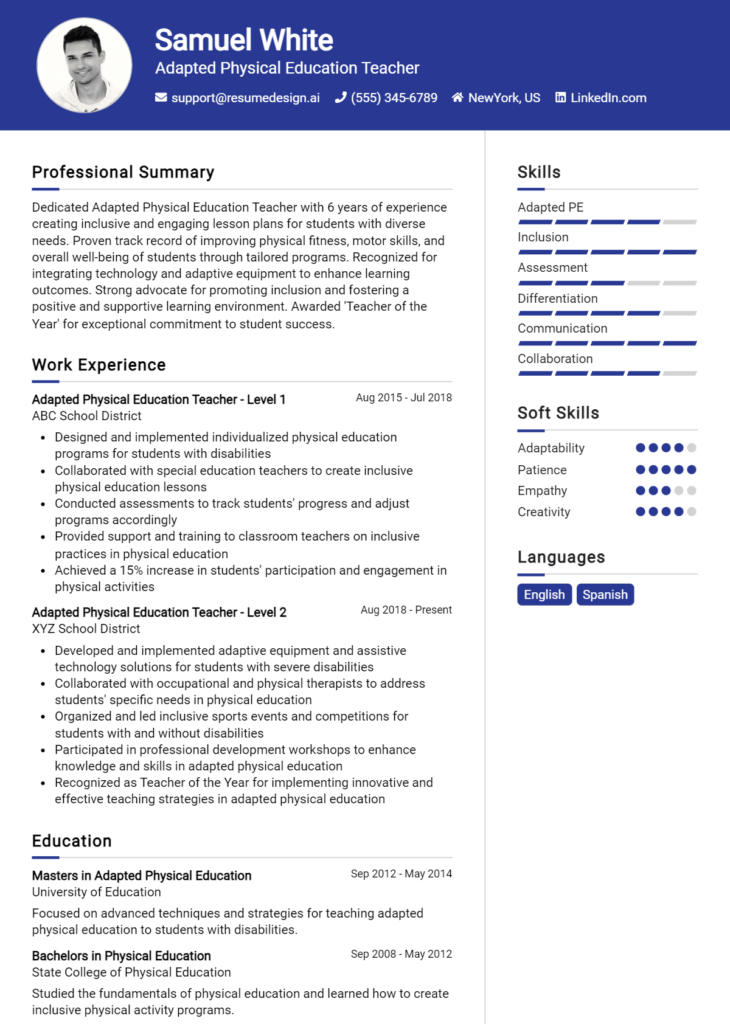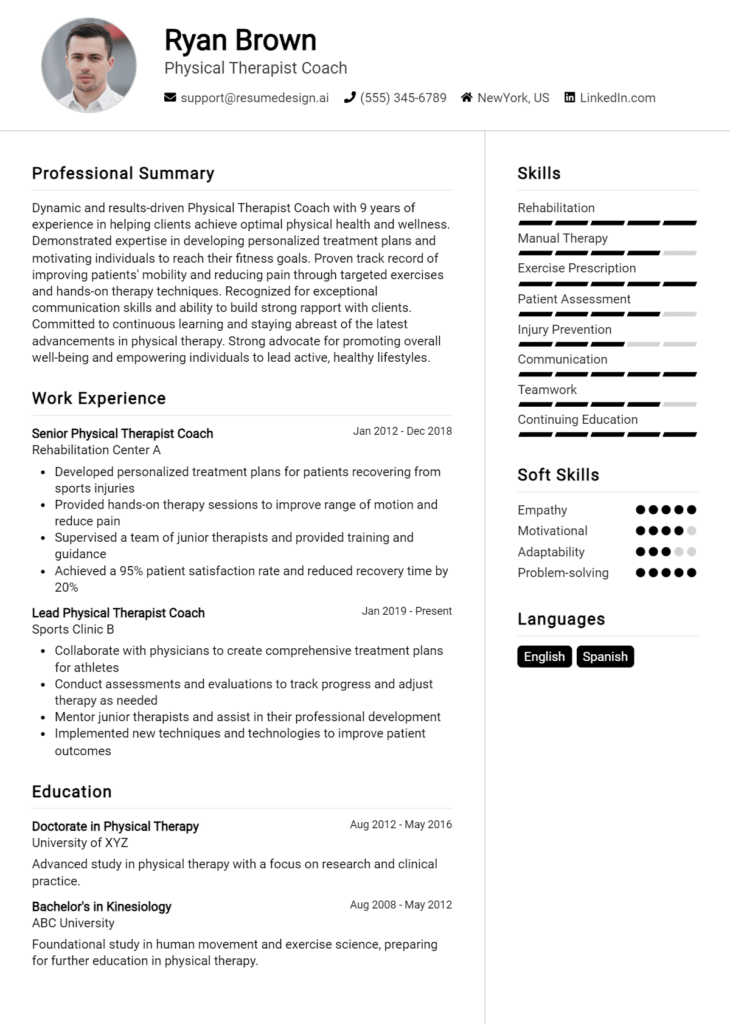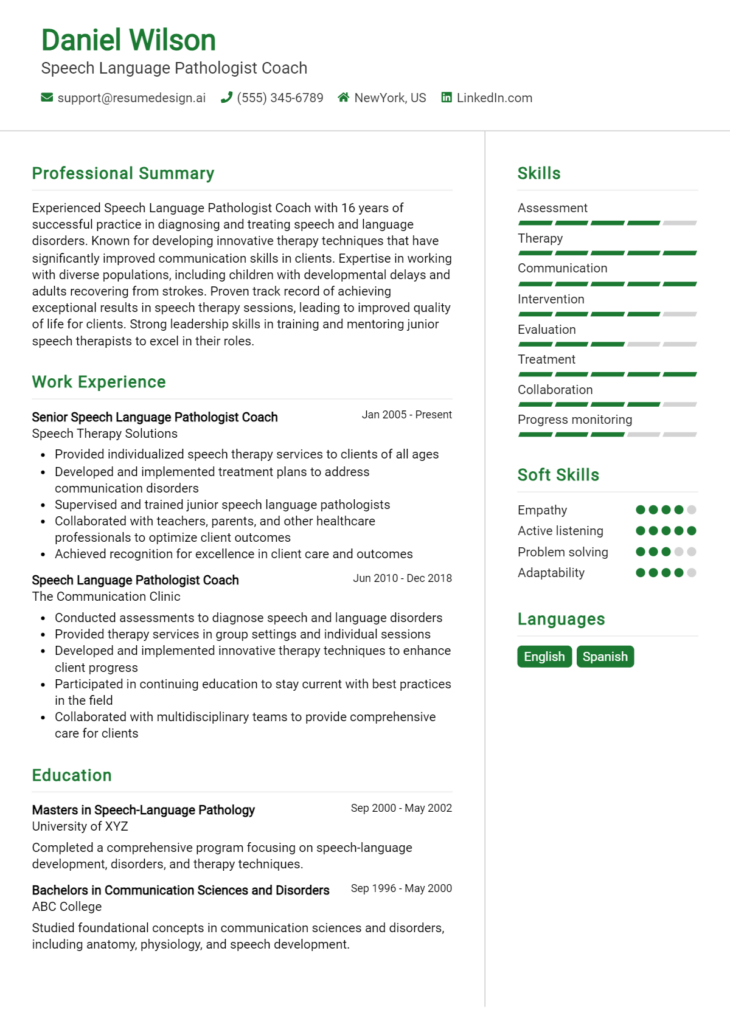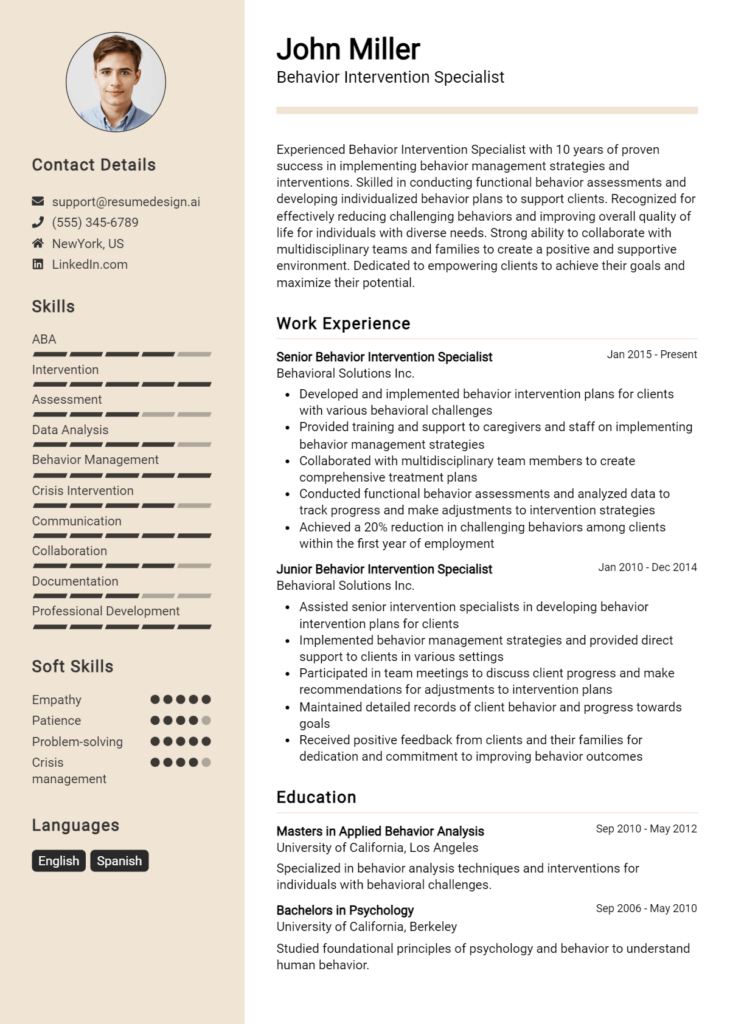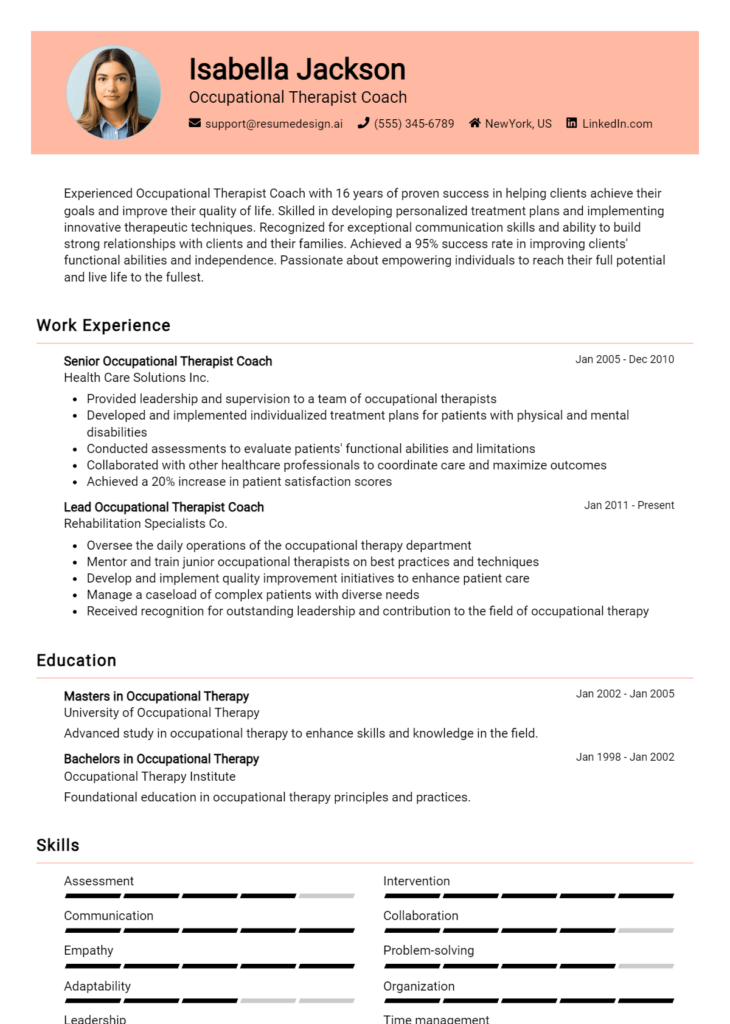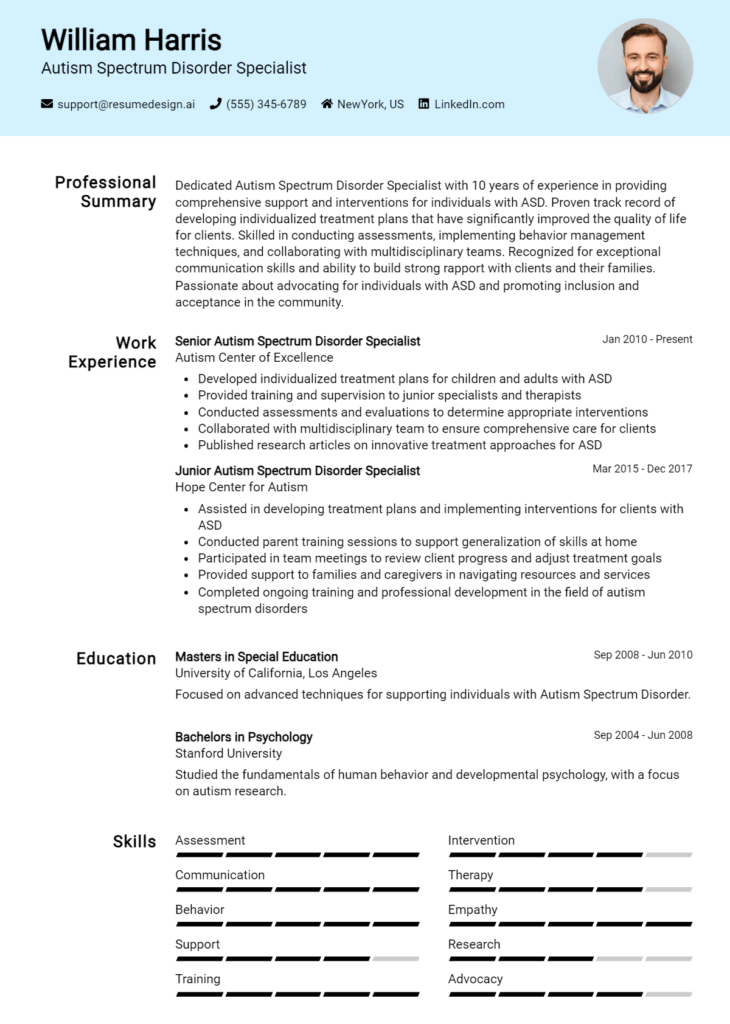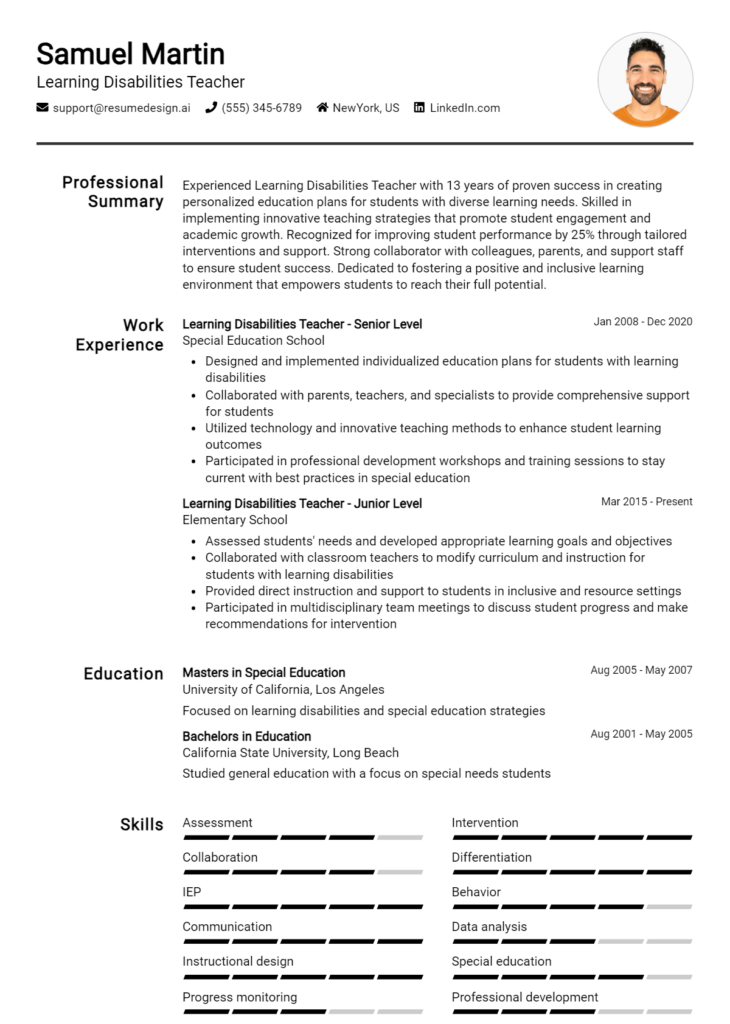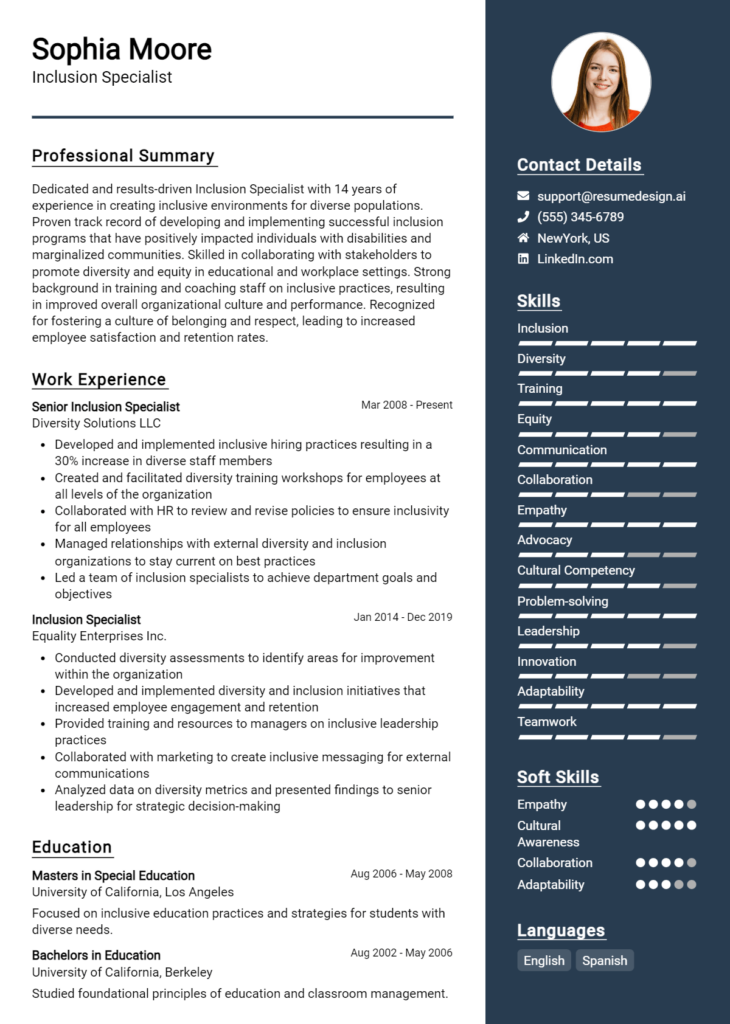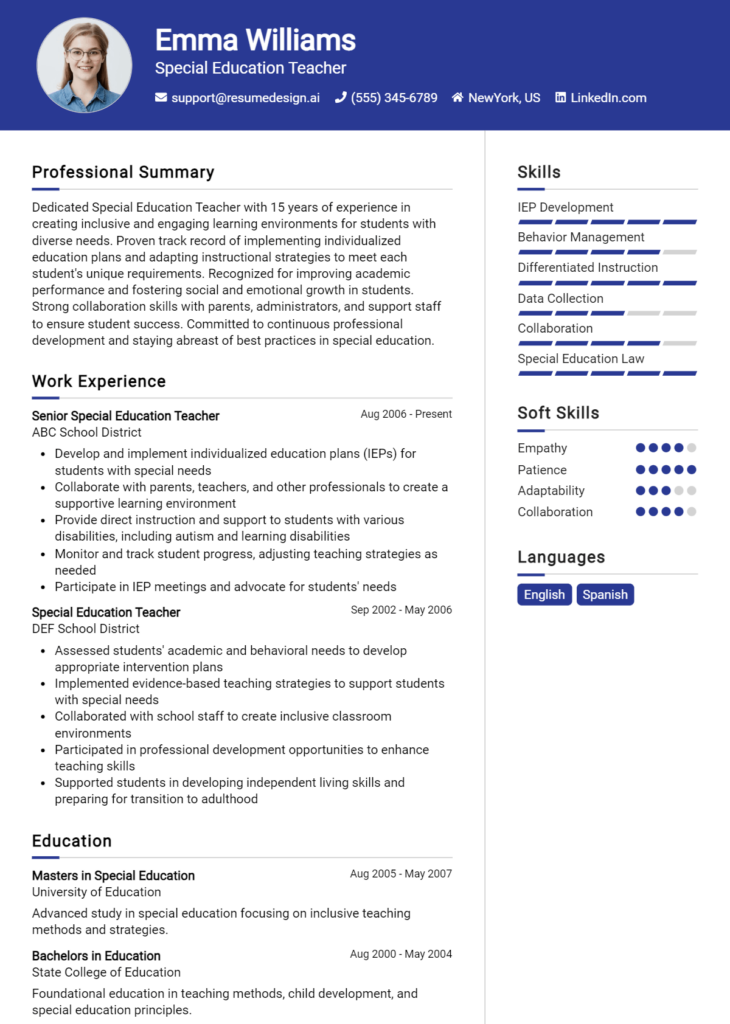Teacher of the Visually Impaired Core Responsibilities
A Teacher of the Visually Impaired plays a vital role in fostering an inclusive educational environment. Key responsibilities include developing tailored lesson plans, utilizing assistive technology, and collaborating with multidisciplinary teams to support students' learning needs. Essential skills encompass technical proficiency, operational management, and adept problem-solving capabilities, which are crucial for addressing diverse challenges. A well-structured resume that highlights these qualifications can effectively demonstrate how the professional contributes to the organization’s overarching goals of accessibility and educational equity.
Common Responsibilities Listed on Teacher of the Visually Impaired Resume
- Develop individualized education plans (IEPs) for students with visual impairments.
- Utilize specialized teaching techniques and assistive technologies.
- Conduct assessments to evaluate student progress and needs.
- Collaborate with general education teachers and support staff.
- Provide training and resources for parents and caregivers.
- Adapt instructional materials for accessibility.
- Implement mobility and orientation training.
- Monitor and report on student achievements and challenges.
- Participate in professional development and community outreach.
- Advocate for students’ rights and educational accessibility.
- Create a supportive and engaging classroom environment.
- Maintain accurate records of student performance and progress.
High-Level Resume Tips for Teacher of the Visually Impaired Professionals
A well-crafted resume is essential for Teacher of the Visually Impaired professionals, as it serves as the first impression a candidate makes on potential employers. In a competitive job market, your resume must effectively reflect your unique skills, experiences, and achievements in this specialized field. It should not only highlight your teaching abilities but also your understanding of assistive technologies, individualized education plans, and strategies tailored for visually impaired students. This guide will provide practical and actionable resume tips specifically tailored for Teacher of the Visually Impaired professionals, ensuring that your application stands out and resonates with hiring managers.
Top Resume Tips for Teacher of the Visually Impaired Professionals
- Tailor your resume to the job description: Customize your resume for each application by incorporating keywords and phrases from the job listing.
- Highlight relevant experience: Focus on your teaching roles, internships, and volunteer work that specifically relate to visually impaired students.
- Showcase your educational background: Include degrees, certifications, and specialized training in visual impairment and related fields.
- Quantify your achievements: Use numbers to demonstrate the impact of your work, such as the percentage of students who improved their reading skills under your instruction.
- Include industry-specific skills: Emphasize your knowledge of assistive technologies, Braille instruction, and adaptive teaching methods.
- Incorporate soft skills: Highlight your communication, empathy, and adaptability, which are essential for working effectively with visually impaired students and their families.
- Utilize a clean and professional format: Ensure your resume is easy to read with clear headings, bullet points, and a consistent font.
- Keep it concise: Aim for one page, focusing on the most relevant information to keep the reader engaged.
- Proofread for errors: Ensure there are no typos or grammatical mistakes, as attention to detail is crucial in education roles.
By implementing these tips, Teacher of the Visually Impaired professionals can significantly enhance their resumes, thereby increasing their chances of landing a job in this rewarding field. A well-structured and targeted resume not only showcases your qualifications but also demonstrates your commitment to supporting visually impaired students, making you a compelling candidate for potential employers.
Why Resume Headlines & Titles are Important for Teacher of the Visually Impaired
In the competitive field of education, particularly for specialized roles such as Teacher of the Visually Impaired, having a well-crafted resume headline or title is crucial. A strong headline acts as a powerful first impression, immediately grabbing the attention of hiring managers and succinctly summarizing a candidate's key qualifications in just a few impactful words. It should be concise, relevant, and tailored to the specific job being applied for, allowing employers to quickly recognize the applicant's expertise and suitability for the role. An effective headline can set the stage for a standout resume, making it more likely for the candidate to move forward in the hiring process.
Best Practices for Crafting Resume Headlines for Teacher of the Visually Impaired
- Keep it concise—aim for one impactful sentence or phrase.
- Ensure relevance to the specific position and responsibilities.
- Highlight key qualifications, such as certifications or years of experience.
- Use action-oriented language to convey enthusiasm and capability.
- Incorporate industry-specific keywords that resonate with the role.
- Showcase unique skills that set you apart from other candidates.
- Avoid jargon or overly complex phrases that may confuse the reader.
- Make sure it reflects your professional identity and career goals.
Example Resume Headlines for Teacher of the Visually Impaired
Strong Resume Headlines
Dedicated Teacher of the Visually Impaired with 10+ Years of Experience in Inclusive Education
Certified Orientation and Mobility Specialist Committed to Empowering Students with Visual Impairments
Passionate Advocate for Accessible Learning Environments and Differentiated Instruction
Weak Resume Headlines
Teacher Looking for a Job
Education Professional
The strong headlines are effective because they are specific, highlighting relevant skills and experience that directly align with the role of a Teacher of the Visually Impaired. They convey a sense of passion and commitment while using precise language that resonates with hiring managers. In contrast, the weak headlines fail to impress due to their vagueness and lack of detail; they do not convey the candidate's unique qualifications or enthusiasm for the position, making it easy for employers to overlook them in a crowded applicant pool.
Writing an Exceptional Teacher of the Visually Impaired Resume Summary
A well-crafted resume summary is crucial for a Teacher of the Visually Impaired, as it serves as the first impression to hiring managers. This brief section allows candidates to quickly showcase their key skills, relevant experience, and significant accomplishments within the field. An impactful summary can capture attention and create interest in the candidate's qualifications, making it essential to be both concise and tailored to the specific job. By highlighting the most pertinent information, a strong summary sets the tone for the rest of the resume and increases the likelihood of securing an interview.
Best Practices for Writing a Teacher of the Visually Impaired Resume Summary
- Quantify achievements: Use specific numbers to illustrate your impact, such as the number of students you've successfully helped.
- Focus on relevant skills: Highlight skills that are specifically applicable to teaching visually impaired students, such as Braille literacy or assistive technology proficiency.
- Tailor the summary: Customize your summary for each job application, aligning it with the specific requirements outlined in the job description.
- Use strong action verbs: Begin sentences with impactful verbs to convey a sense of initiative and effectiveness.
- Keep it concise: Aim for 3-5 sentences that pack a punch without overwhelming the reader.
- Highlight certifications: Mention any relevant certifications or specialized training that enhance your qualifications.
- Showcase passion: Include a sentence that reflects your dedication and passion for teaching visually impaired students.
- Review for clarity: Ensure that your summary is clear and free of jargon, making it easily understandable to all readers.
Example Teacher of the Visually Impaired Resume Summaries
Strong Resume Summaries
Dedicated Teacher of the Visually Impaired with over 5 years of experience implementing individualized education plans (IEPs) that improved student engagement by 30%. Proficient in the use of Braille and assistive technology, successfully guiding students to achieve their academic goals. Certified in Orientation and Mobility, with a passion for fostering independence among visually impaired learners.
Compassionate educator specializing in visual impairment, with a Master’s degree in Special Education and a track record of enhancing literacy skills in students through innovative teaching methods. Achieved a 40% increase in reading comprehension scores among students within one academic year by utilizing adaptive learning strategies and personalized instruction.
Results-driven Teacher of the Visually Impaired with a proven ability to collaborate with multidisciplinary teams to create inclusive classroom environments. Developed and executed engaging curriculum tailored to diverse learning needs, resulting in 95% parental satisfaction ratings and significant student progress on state assessments.
Weak Resume Summaries
Experienced teacher looking for a position to help visually impaired students. I have worked with different types of students and am knowledgeable about various methods.
I am a teacher who loves working with kids and has some experience in teaching the visually impaired. I want to find a job where I can make a difference.
The strong resume summaries are effective because they provide specific examples of achievements, quantify results, and align directly with the role's requirements. They showcase relevant skills and indicate the candidate's passion for teaching visually impaired students. In contrast, the weak summaries lack detail and specificity, failing to illustrate the candidate’s unique qualifications or the impact of their experience. This vagueness may leave hiring managers uninterested, highlighting the importance of a compelling summary in a competitive job market.
Work Experience Section for Teacher of the Visually Impaired Resume
The work experience section of a Teacher of the Visually Impaired resume is vital as it provides potential employers with a comprehensive view of the candidate's professional background. This section effectively showcases the technical skills necessary for supporting visually impaired students, the ability to manage teams in educational settings, and the delivery of high-quality educational products. Quantifying achievements, such as improved student outcomes or successful program implementations, and aligning experience with industry standards are crucial for demonstrating the candidate's qualifications and readiness for the role.
Best Practices for Teacher of the Visually Impaired Work Experience
- Highlight specific technical skills related to assistive technology and adaptive teaching methods.
- Quantify achievements by using metrics, such as percentage improvements in student performance.
- Describe collaborative projects with other educators, specialists, or organizations focused on visual impairment.
- Include relevant certifications or training that enhance your teaching capabilities.
- Focus on leadership roles in team settings to demonstrate your ability to guide and mentor others.
- Tailor the experience descriptions to align with the requirements of the position you are applying for.
- Utilize action verbs to convey a sense of proactivity and accomplishment.
- Incorporate feedback or testimonials from colleagues or supervisors to bolster credibility.
Example Work Experiences for Teacher of the Visually Impaired
Strong Experiences
- Developed and implemented an adaptive reading program that resulted in a 30% increase in reading comprehension scores among visually impaired students over one academic year.
- Led a team of five special education teachers in creating inclusive classroom activities, resulting in a 15% improvement in student engagement, as measured by attendance and participation rates.
- Collaborated with technology specialists to integrate assistive devices, enhancing learning accessibility for 100% of visually impaired students, thereby increasing overall academic performance.
- Trained 20 staff members on the use of Braille and other adaptive materials, leading to a more cohesive teaching approach that improved student outcomes by 25%.
Weak Experiences
- Taught visually impaired students in various subjects without specifying methods or outcomes.
- Worked with a team of teachers, but did not detail any specific contributions or results.
- Assisted in classroom activities with no measurable impact on student learning.
- Attended workshops and training sessions related to visual impairment without mentioning any application of skills learned.
The examples provided illustrate the distinction between strong and weak work experiences. Strong experiences showcase quantifiable outcomes, specific technical skills, and collaborative efforts that directly contribute to student success. In contrast, weak experiences lack detail and measurable impact, failing to convey the candidate's effectiveness or expertise in the field of teaching visually impaired students.
Education and Certifications Section for Teacher of the Visually Impaired Resume
The education and certifications section of a Teacher of the Visually Impaired resume is crucial in showcasing the candidate's academic qualifications and specialized knowledge pertinent to the role. This section not only reflects the individual's educational background but also highlights their commitment to professional development through industry-relevant certifications and ongoing learning efforts. Including pertinent coursework, specialized training, and recognized credentials can significantly bolster the candidate's credibility, demonstrating their preparedness to meet the unique needs of visually impaired students.
Best Practices for Teacher of the Visually Impaired Education and Certifications
- Focus on relevant degrees and certifications specific to teaching the visually impaired.
- Include any specialized training in assistive technologies or adaptive teaching methods.
- List coursework that directly relates to visual impairment, special education, or related fields.
- Highlight advanced degrees or credentials that demonstrate a higher level of expertise.
- Maintain a clear and organized format, making it easy for employers to scan for key information.
- Update the section regularly to reflect new certifications or relevant professional development.
- Consider adding a brief description of each certification or degree to provide context.
- Tailor the section to match job descriptions, ensuring alignment with the specific skills and knowledge required for the position.
Example Education and Certifications for Teacher of the Visually Impaired
Strong Examples
- M.S. in Special Education with a focus on Visual Impairments, University of XYZ, 2021
- Certified Teacher of the Visually Impaired (TVI), National Certification in Special Education, 2020
- Coursework in Orientation and Mobility Techniques, University of ABC, 2019
- Training in Assistive Technology for the Visually Impaired, Professional Development Institute, 2022
Weak Examples
- B.A. in English Literature, University of DEF, 2010 (not related to visual impairment)
- Certification in Basic First Aid, Red Cross, 2018 (not specific to teaching visually impaired students)
- Coursework in General Psychology, University of GHI, 2015 (lacks relevance to the role)
- Outdated certification in Special Education (from 2005) without renewal or specialization updates.
The strong examples are considered effective because they directly align with the qualifications and skills necessary for a Teacher of the Visually Impaired, showcasing both relevant education and specialized training. In contrast, the weak examples lack direct relevance to the role, featuring outdated or unrelated qualifications that do not support the candidate's expertise in teaching visually impaired students.
Top Skills & Keywords for Teacher of the Visually Impaired Resume
As a Teacher of the Visually Impaired, possessing the right set of skills is essential to effectively support and educate students with visual impairments. These skills not only enhance the teacher's ability to deliver tailored instruction but also foster a nurturing and inclusive learning environment. A well-crafted resume that highlights both hard and soft skills can significantly improve a candidate's chances of securing a position in this specialized field. By showcasing expertise in adaptive techniques, communication, and collaboration, educators can demonstrate their commitment to empowering visually impaired students, ultimately contributing to their academic success and personal growth.
Top Hard & Soft Skills for Teacher of the Visually Impaired
Soft Skills
- Empathy and Compassion
- Effective Communication
- Patience and Understanding
- Adaptability and Flexibility
- Problem-Solving Skills
- Team Collaboration
- Active Listening
- Creativity in Teaching Methods
- Time Management
- Cultural Sensitivity
Hard Skills
- Knowledge of Braille and Other Tactile Techniques
- Proficiency in Assistive Technology
- Curriculum Development for Visually Impaired Students
- Orientation and Mobility Training
- Understanding of Visual Impairment Conditions
- Experience with Individualized Education Plans (IEPs)
- Instructional Strategies for Inclusive Education
- Assessment and Evaluation Techniques
- Familiarity with Accessibility Standards
- Classroom Management Skills
By focusing on these skills and ensuring relevant work experience, candidates can present themselves as well-rounded and capable educators dedicated to the success of their students.
Stand Out with a Winning Teacher of the Visually Impaired Cover Letter
Dear [Hiring Manager's Name],
I am writing to express my interest in the Teacher of the Visually Impaired position at [School/Organization Name], as advertised on [where you found the job posting]. With a Master’s degree in Special Education and over five years of dedicated experience working with students with visual impairments, I am excited about the opportunity to contribute my skills and passion for inclusive education to your team. I firmly believe that every child deserves the chance to thrive, and I am committed to fostering an environment where students can build confidence and achieve their full potential.
Throughout my career, I have developed and implemented individualized education plans (IEPs) that cater to the unique needs of my students. My experience includes teaching students with a range of visual impairments, from partial sight to total blindness, and utilizing various adaptive technologies and teaching strategies to enhance their learning experiences. I am proficient in Braille, assistive technology, and other resources that support accessibility in the classroom. My ability to collaborate closely with parents, specialists, and support staff has resulted in positive outcomes for my students, as we work together to create a comprehensive and supportive educational environment.
I am particularly drawn to [School/Organization Name] because of your commitment to inclusive education and the emphasis you place on fostering a community that values diversity. I admire your innovative approaches to teaching and your focus on empowering students with disabilities. I am eager to bring my expertise in visual impairment education to your school and contribute to your mission of providing high-quality, equitable education for all students.
Thank you for considering my application. I look forward to the opportunity to discuss how my background, skills, and enthusiasms align with the goals of [School/Organization Name]. I am excited about the possibility of joining your team and helping to create an enriching learning environment for visually impaired students.
Sincerely,
[Your Name]
[Your Contact Information]
Common Mistakes to Avoid in a Teacher of the Visually Impaired Resume
When crafting a resume for the position of a Teacher of the Visually Impaired, it's essential to showcase your unique qualifications and experiences effectively. However, many candidates make common mistakes that can hinder their chances of landing an interview. Avoiding these pitfalls can help you create a more polished and professional resume that highlights your expertise in supporting students with visual impairments.
Neglecting Relevant Experience: Failing to highlight specific teaching experience with visually impaired students can leave hiring managers questioning your suitability for the role.
Ignoring Specialized Skills: Not including specialized skills such as Braille proficiency, assistive technology knowledge, or adaptations for lesson plans can make your resume less competitive.
Using Generic Language: Employing vague terms rather than specific descriptors can weaken your resume. Use clear, concrete language to describe your accomplishments and responsibilities.
Overloading with Irrelevant Information: Including unrelated work experience or excessive personal details can distract from your relevant qualifications and dilute your professional narrative.
Forgetting Certifications and Training: Omitting critical certifications or specialized training in visual impairment education can lead to missed opportunities, as these credentials are often essential in the field.
Lacking Quantifiable Achievements: Failing to provide measurable outcomes related to your teaching can make it difficult for employers to gauge the impact of your work. Use statistics or specific examples to illustrate your success.
Ignoring Format and Readability: A cluttered or poorly structured resume can be difficult to read. Ensure your layout is clean, and use bullet points and headings for easier navigation.
Not Tailoring the Resume: Submitting a one-size-fits-all resume without customizing it to the specific job description can signal a lack of genuine interest in the position. Tailor your resume to reflect the skills and experiences that align with the job requirements.
Conclusion
As a Teacher of the Visually Impaired, you play a crucial role in fostering an inclusive learning environment for students with visual impairments. Your expertise not only supports academic achievement but also enhances the overall quality of life for these students. Key responsibilities include developing tailored educational plans, using adaptive technologies, and effectively collaborating with parents and other educators. In addition, it’s vital to stay updated with the latest teaching strategies and resources available for visually impaired learners.
To ensure you present your unique qualifications and experiences effectively, it’s essential to regularly review and update your resume. Highlight your relevant skills, certifications, and successes in the classroom to attract potential employers.
To assist you in this process, consider utilizing tools such as resume templates to create a polished and professional document. Explore the resume builder for an easy way to customize your resume, or check out resume examples for inspiration. Additionally, don’t forget the importance of a well-crafted cover letter, which you can create using cover letter templates.
Take action today to enhance your resume and make a strong impression in your job search as a Teacher of the Visually Impaired!

